The beauty of writing a blog with a focus on illustration is that I can downplay the story if it’s unremarkable, or if, as with the case of Od Baśni do Baśni (From Story to Story), it is so remarkable that it is beyond comprehension. Not that Polish is particularly remarkable, but it is beyond comprehension, especially for those of us who are not familiar with the language, and/or have a fondness for vowels.
The book was unearthed in the basement of the parents of my brother in law. Sadly, they passed away this last  year, and now their children are sifting through the remnants of their long lives. No one remembers this book, or how it came to be in their possession. Published in 1965, it’s certainly of the era of my brother in law’s childhood, but the provenance is uncertain. Nevertheless, it is now in my hands, if temporarily, and I couldn’t be more tickled.
year, and now their children are sifting through the remnants of their long lives. No one remembers this book, or how it came to be in their possession. Published in 1965, it’s certainly of the era of my brother in law’s childhood, but the provenance is uncertain. Nevertheless, it is now in my hands, if temporarily, and I couldn’t be more tickled.
 Although not familiar with Jan Marcin Szancer, the illustrator of od Baśni do Baśni, his style (at least in this particular outing) is straight out of the sixties. The unusually vibrant colour plates may be a result of the era’s pre-separation printing process, but regardless of how the images made it to the page, Szancer’s illustrations (in colour and black & white) bare a striking similarity to the work of his compatriots outside of Poland. Certainly, Szancer’s humourous and delightfully jaunty approach to illustration is not unlike Ronald Searle or even Paul Galdone, which makes the stories even more tantalizing. Something funny is going on here, but what?
Although not familiar with Jan Marcin Szancer, the illustrator of od Baśni do Baśni, his style (at least in this particular outing) is straight out of the sixties. The unusually vibrant colour plates may be a result of the era’s pre-separation printing process, but regardless of how the images made it to the page, Szancer’s illustrations (in colour and black & white) bare a striking similarity to the work of his compatriots outside of Poland. Certainly, Szancer’s humourous and delightfully jaunty approach to illustration is not unlike Ronald Searle or even Paul Galdone, which makes the stories even more tantalizing. Something funny is going on here, but what?
Jan Brzechwa (1900–1966), was a Polish poet whose real name was Jan Lesman. He wrote for both adults and children, including fairy tales and several fantasy novels featuring Mr Blot, an eccentric wizard. Brzechwa was also a lawyer specializing in copyright law, and following WWII, worked for UNESCO. According to several brief (English) mentions 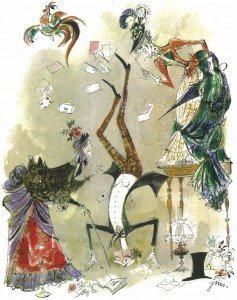 on the internet, Brzechwa’s absurdist verse and experimental rhythmic variations is comparable to Dr Seuss. I will take their word for it. Although Szancer’s illustrations are amusing, unlike Seuss they are grounded in pseudo-reality (goats, foxes, princesses, knights, bears, and the like), so one could make the assumption that Brzechwa’s stories are equally conventional. A quick translation of the 10 titles included in od Baśni do Baśni suggest otherwise~
on the internet, Brzechwa’s absurdist verse and experimental rhythmic variations is comparable to Dr Seuss. I will take their word for it. Although Szancer’s illustrations are amusing, unlike Seuss they are grounded in pseudo-reality (goats, foxes, princesses, knights, bears, and the like), so one could make the assumption that Brzechwa’s stories are equally conventional. A quick translation of the 10 titles included in od Baśni do Baśni suggest otherwise~
Pan Drops i jego trupa translates (roughly) to Mr Drops and his Corpse. Unlikely to become part of the Disney oeuvre, although Tim Burton may be interested in a movie version, with Johnny Depp playing both Mr Drops and the Corpse. In Pan Szczuka (Mr Szczuka), a fellow in Teutonic jacket and knee socks catches a ‘fashionably dressed devil’, parading him around town on a leash.
Baśń o Stalowym Jeżu is The Tale of the Steel Jesus, or if you prefer, Jesus Christ, Man of Steel. Of all the stories in the book, this one is the most intriguing. A loose translation of the first couple of stanzas yields the following: Baśń o Stalowym Jeżu is about magical mechanical shop, which is always closed, and yet all manner of curious, metal thingamajigs can be seen through the windows, including a knight in prickly armour. It would appear the diminutive knight is willing and able to take on a variety of foes ranging from bats to a blue imp sitting in a tree. Not sure how Jesus fits in here, but I suspect a moral lesson awaits anyone who is able to read Baśń o Stalowym Jeżu, in spite of the illustrations which suggest, at least visually, a Polish Monty Python and the Holy Grail. Or, upon further consideration….Jeżu might in fact be a hedgehog, in which case there is likely no moral, just one tiny (but brave) creature, wrapped in metal armour.
It’s weird stuff, for sure, but the best fairy tales fly their freak flags proudly. It’s the oddities, visual, cultural and otherwise, that make stories memorable, if not completely irresistible.
Jan Marcin Szancer (1902-1973) studied at Kraków’s Academy of Fine Art, and was a professor at the Academy of Fine Arts in Warsaw. Szancer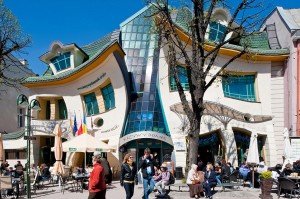 illustrated more than 240 books and fairy tales, including classic works by Adam Mickiewicz, Juliusz Sůowacki, Aleksander Fredro, Julian Tuwim, and Jan Brzechwa. His popularity as a children’s picture book illustrator is so entrenched, a crazy and exceptionally beautiful house was built in Sopot, Poland, based on his fairy tale drawings. The Krzywy Domek , or Crooked House, is a very fine tribute to a great, if internationally obscure, artist.
illustrated more than 240 books and fairy tales, including classic works by Adam Mickiewicz, Juliusz Sůowacki, Aleksander Fredro, Julian Tuwim, and Jan Brzechwa. His popularity as a children’s picture book illustrator is so entrenched, a crazy and exceptionally beautiful house was built in Sopot, Poland, based on his fairy tale drawings. The Krzywy Domek , or Crooked House, is a very fine tribute to a great, if internationally obscure, artist.
Thanks to Mr and Mrs Adamowicz for bringing Od Baśni do Baśni to my attention, albeit in a roundabout way. I wish I could ask them about this book, and maybe have them read, in their often bemused Polish accents, the tale of a plucky knight and the magical, mechanical shop. And thank you to my brother in law for providing the translations, which bemused us both.
Od Baśni Do Baśni, written by Jan Brzechwa, with illustrations by Jan Marcin Szancer. Published by Drukarnia Narodowa w Krakowie (I think), 1965
And now…more extraordinary illustrations from Od Baśni Do Baśni by JM Szancer~
Przygody rycerza Szaławiły, or Szaławiły rides the wild tuna
From Wyprawa Na Ariadnie…
…and just in case you didn’t catch the item of interest in Wyprawa Na Ariadnie
The five musketeers from Baśń O Korsarzu Palemonie
Za Krola Jelonka, which surprisingly, does not translate into Attack of the Grasshoppers
Pan Szczuka takes Beelzebub for walkies

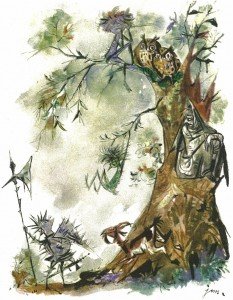
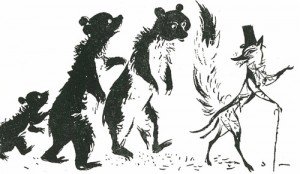
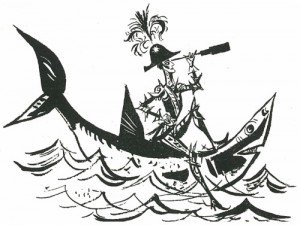






Hello there. 🙂
I came across your website by coincidence, but I found your review really interesting. It never occured to me to compare Brzechwa to Dr Seuss! 😀
However, I am not surprised that the titles of the stories may seem somewhat confusing to you – there are a few mistakes in the translation. 😉 Let me help you out:
‘Pan Drops i jego Trupa’ translates to ‘Mr Drops and his troupe’, not ‘his corpse’ (in Polish ‘trup’ means ‘corpse’, but ‘trupa’ is ‘troupe’ or ‘crew’). It is a story about a young boy who needs to leave his home after his father’s death and his brothers offer him various animals as their goodbye presents: a stork, a squirrel, a mouse, a snail, and a centipede. They perform together and become famous.
‘Baśń o Stalowym Jeżu’ is in fact about a steel Hedgehog or Urcheon, not about Jesus (Polish ‘Jezu’ or ‘Jezus’ = Jesus, but ‘o jeżu’ = about a hedgehog/urcheon). The knight is named Urcheon after his spiky armor. He was cursed by the Magic Mechanic and seeks a way to break the spell.
I hope this help at least a little. Have fun with exploring Brzechwa’s stories!
Thanks very much! I figured something would be lost in translation, but it was certainly a lot of fun interpreting the illustrations based on just a few words, however garbled. As you say, there is a big difference between Jesus and a Hedgehog, or so I’m told, but regardless, Baśń o Stalowym Jeżu is a fantastic story with wonderful illustrations, and I’d love to see an English version some day…
Wonderful illustrations and commentary. Thanks for highlighting these books!
Thanks Rob! Yeah, this book was a real find…46 years in the making.
What a find? WOw. Quirky set illustrations as well
“Pan Drops i jego trupa” means something more conventional – “Mr Drops and his TROUPE” 🙂 Greetings from Poland – A Big Szancer’s Fan
P.S. In fact, I am sure, Szancer’s sensibility and imagination have been influencing several generations of children here. I strongly feel they are difficult to replace. For me, only The Wind in the Willows can compare.
It is fantastic to see one of the Szancer’s illustrated books here. For me he is my beloved Polish children books’ illustrator however we had many of them (check also Grabowski master of animal illustration). Brzechwa is a poet which made stories and poems for kids we read all in youth, and many of them know by heart (another poet like this was Julian Tuwim).
“Pan Drops i jego trupa” means Mr Drops and his Troupe. “Baśń o stalowym jeżu” its fairytale about steel hadgehog (and has nothing to do with religion), it’s a tale about knight enchanted into hedgehog. Idea probably comes from widely known lullaby, and writer Andrzej Sapkowski, author of “The Witcher” fantasy serie from 90’s used this story in one of his books.
Oh wonderful! Thanks. Yes, this book is a little treasure, and opened my eyes to some amazing Polish illustrators and writers.